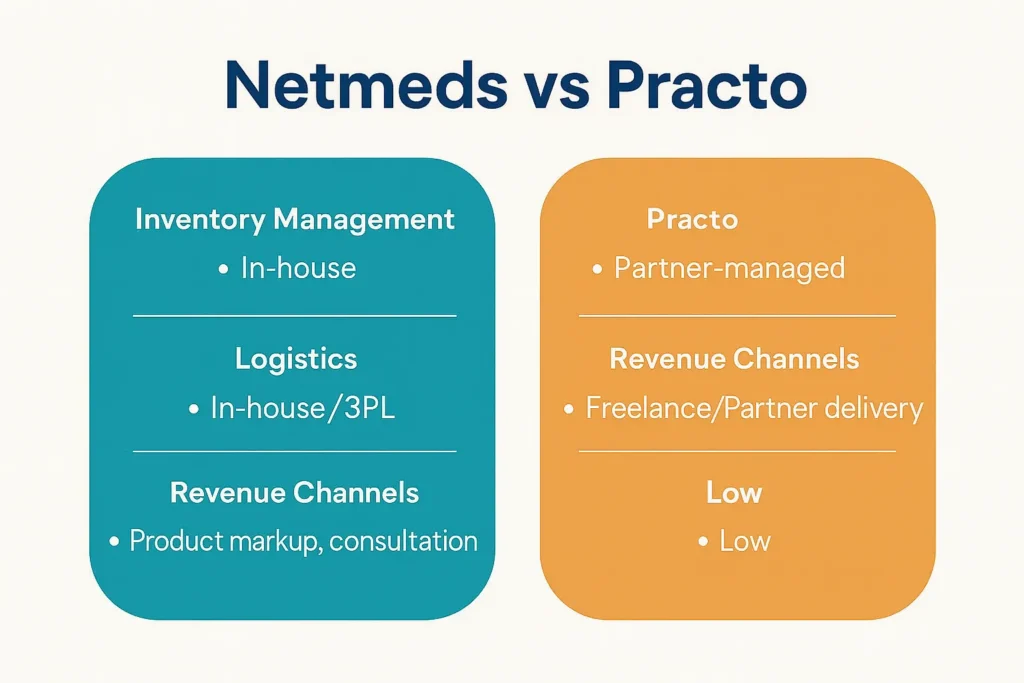In 2025, healthcare and medicine delivery startups are booming like never before. With increasing demand for digital health solutions, medicine delivery, and decentralized pharma platforms, entrepreneurs and investors are exploring business models that offer scalability, low operational overhead, and market adaptability.
Netmeds, one of India’s most established online pharmacies, and Practo, an emerging player leveraging decentralized logistics, represent two very different takes on the same vertical. As a startup founder or app entrepreneur, deciding between a traditional full-stack model like Netmeds and a decentralized marketplace model like Practo can shape your operational structure, partner ecosystem, and ultimately, your path to profitability.
This blog unpacks the core business models, revenue structures, cost breakdowns, and startup viability of Netmeds vs Practo to help you make a future-proof decision in 2025.

What is Netmeds?
Netmeds is a full-stack online pharmacy founded in 2015 and acquired by Reliance Retail in 2020. It provides:
- Prescription and OTC (over-the-counter) medications
- Diagnostic tests
- Wellness products
- Teleconsultation
Netmeds functions as a centralized platform with warehousing, logistics, and fulfillment integrated under its brand. It maintains partnerships with drug manufacturers, diagnostic labs, and last-mile delivery providers to ensure end-to-end control.
What is Practo?
Practo is an emerging decentralized healthtech platform focusing on peer-to-peer pharmaceutical delivery and local vendor aggregation. Think of it as the “Uber Eats for Medicines”—instead of owning stock or delivery infrastructure, it connects:
- Local pharmacies
- Independent health service providers
- Freelance delivery agents
Practo acts as a marketplace enabler and monetizes through commissions, subscriptions, and data analytics services, providing lean scalability with minimal upfront investment.
Business Model of Netmeds
Revenue Streams
- Direct Sales: Markup on prescription and OTC drugs
- Diagnostic Commissions: Percentage from partnered labs
- Online Consultation Fees
- Advertising by pharma companies and wellness brands
- Subscription Plans (discounts, express delivery)
Cost Structure
- Warehousing & cold-chain logistics
- In-house tech & infrastructure
- Pharma inventory procurement
- Staff and compliance overheads
- Marketing & customer acquisition
Key Partners
- Pharmaceutical manufacturers
- Third-party logistics (3PL)
- Diagnostic labs
- Doctors and teleconsultation networks
- Government regulators (CDSCO)
Growth Strategy
- Pan-India delivery expansion
- Strategic pricing & discounts
- Value-added services (e.g., health cards)
- Integration with Reliance ecosystem (Jio Health, MyJio)
Learn More: Business Model of Netmeds:Strategy & Revenue Insights
Business Model of Practo
Revenue Streams
- Commission from each order placed via the app
- Vendor Subscriptions for premium listing and analytics
- Surge Pricing Fees during high demand
- In-app Ads for local pharmacies
- API integrations with insurance & diagnostics
Cost Structure
- Platform development & maintenance
- Partner acquisition & onboarding
- Payment gateway & compliance costs
- Incentives for new customers and delivery partners
Key Partners
- Local pharmacies
- Independent delivery agents
- API providers (payment, insurance, ID verification)
- Community health workers
Growth Strategy
- Hyperlocal expansion
- Blockchain-backed prescription tracking (future-ready)
- Community marketing
- Integration with health wallets & microinsurance
Learn More: Business Model of Practo: Revenue Streams,Features .
Netmeds vs Practo: Comparison Table
| Feature | Netmeds | Practo |
|---|---|---|
| Model Type | Full-stack ePharmacy | Decentralized Aggregator |
| Inventory Management | In-house | Partner-managed |
| Logistics | In-house/3PL | Freelance/Partner delivery |
| Revenue Channels | Product markup, consultation | Commission, subscriptions |
| CAPEX | High | Low |
| Scaling | Slower, infra-heavy | Fast, agile |
| Compliance | Centralized | Distributed/localized |
| Entry Barrier | High (inventory, infra) | Medium (tech + partners) |
| Profitability Timeline | Long-term | Short to medium term |
| Target Audience | Urban, Tier 1-2 | Tier 2-3, underserved areas |
Pros & Cons of Netmeds Business Model
Pros
- Full control over product quality
- Strong brand trust
- Recurring revenue via diagnostics and telehealth
- Scalability via Reliance ecosystem
Cons
- Capital intensive
- Regulatory hurdles for drug storage
- Slower to expand to rural areas
- Fixed cost risks
Pros & Cons of Practo Business Model
Pros
- Asset-light and scalable
- Easy to localize per region
- Rapid onboarding of new pharmacies
- Community-driven marketing
Cons
- Less control over drug sourcing
- Compliance risks with third-party actors
- Delivery inconsistency
- Brand trust takes time to build
Market Data: Growth, Revenue & Funding
Global & Indian HealthTech Market (2025)
- India ePharmacy market: Expected to reach $9 billion by 2025
- Healthtech funding in India (2024): Over $1.5 billion
- Global trend: Rise of decentralized models in Africa, LATAM
Netmeds Stats
- Acquired by Reliance for ~$83M
- Over 20 million customers
- 70% repeat customer rate
- Estimated revenue (2024): $100M+
Practo Insights (Emerging)
- Operates in 8 cities as of early 2025
- Raised seed funding of $4M in late 2024
- 25% MoM order volume growth
- Targeting Tier 3 and rural markets aggressively
Which Model is Better for Startups in 2025?
In 2025, startups need to be capital efficient, compliance-smart, and user-trusted.
- If you’re backed by large funding or corporate muscle, Netmeds-style offers long-term control and brand loyalty.
- If you’re bootstrapped or operating in emerging areas, Parcto’s model provides faster returns, lower CAPEX, and room to pivot quickly.
Choose wisely based on your market, funding stage, and user base.
Choose Netmeds-style if…
- You want tight control over fulfillment and quality
- You’re targeting urban metros with high compliance requirements
- You’re building a super-app or corporate health platform
Build your custom Netmeds clone with Miracuves
Choose Practo-style if…
- You’re targeting underserved Tier 2-3 towns
- You want to launch lean and scale fast
- You plan to onboard local vendors and freelancers
Launch your custom Practo clone with Miracuves
Conclusion
Whether you’re drawn to the robust, centralized infrastructure of Netmeds or the lean, hyperlocal flexibility of Practo, Miracuves has your back.
From custom clone app development to end-to-end tech strategy, we help healthtech entrepreneurs build reliable, scalable, and user-loved platforms that meet 2025 standards.
Ready to make your move? Consult Miracuves today to get started.
FAQs
1. What is the main difference between Netmeds and Practo business models?
Netmeds is a centralized ePharmacy with full-stack logistics and inventory, while Practo uses a decentralized aggregator model, connecting local pharmacies and delivery partners.
2. Which business model is more scalable for startups?
Parcto’s model is more scalable with low capital investment and quicker market entry, especially in Tier 2 and 3 cities.
3. How does Practo generate revenue without holding inventory?
Practo earns via commission from orders, subscriptions from pharmacies, and in-app advertising, operating as a marketplace facilitator.
4. Is the Netmeds model viable for rural markets?
Due to infrastructure and logistic limitations, Netmeds faces challenges in rural scalability compared to decentralized models.
5. Can I build a Practo-style app with Miracuves?
Absolutely. Miracuves offers a Paxful clone with multi-crypto support, payment integrations, loyalty programs, and more — all for just $2899.








